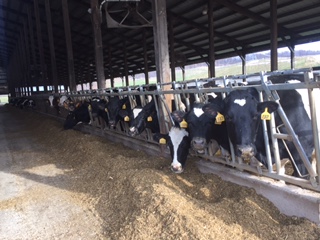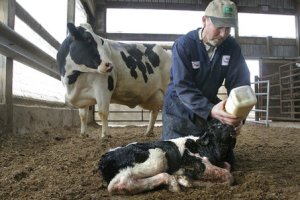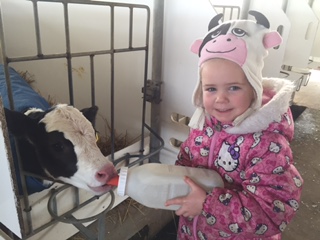Milking
We milk 300 cows twice a day at 4:30 am and 4:00 pm. Usually there are 2-3 people milking. One or two people work in the parlor and one person moves cow groups and scrapes manure out of the barns with a skid steer (Bobcat). Each milking takes about 4 hours.
Our milking parlor is set for 24 cows to be milked at one time. The average amount of milk from each cow per day is approximately 9 gallons. We ship about a semi load of milk every other day.
Feeding
Cows are fed twice a day. We feed them with a tractor pulling a mixer with scales on it. A nutritionist from Hopkins Elevator balances the ration. Our feed includes a mineral and and vitamin supplement from Hopkins Elevator and Nobis Agri Service. They also get spent brewers grain from Bell’s Brewery. However the bulk of their feed consists of:
- corn silage (the whole corn plant chopped up and fermented)
- baled hay
- haylage (chopped and fermented hay)
- corn earlage (ground up corn ears)
- soybean meal (for protein)

Feeding time
(To read more about our crops, go HERE.)
Housing/Bedding
Our cows are housed in free stall barns. This is a loose housing with individual stalls. Cows can lay in whatever stall they choose. The barns have industrial curtains which are closed for warmth in the winter and opened for fresh breezes in the summer.
We bed the cows weekly with screened sand from Van Gemert & Sons Excavating in Kalamazoo. Sand is comfortable for cows. It’s inorganic, so bacteria can’t grow, and it provides excellent traction as the cows kick it into the alley when they get up. This prevents falls and injuries.
We scrape the manure out of the barns every time we get the cows out to milk, then haul and spread the manure on the fields four days a week. (For more specifics about manure, go HERE.)
Caring for Calves

Fred Jr. bottle feeds a newborn calf
A cow has a calf every year. Having a calf is what brings them into milk production. The calves are brought to a nursery barn after birth and fed milk with a bottle twice a day for two weeks. They then drink milk out of buckets another six weeks. At eight weeks they begin eating a starter feed until they are about six months old, when they are ready to digest our homegrown silage.

Fred Jr.’s granddaughter helps bottle feed a calf
We keep female calves (heifers) and sell most of our male calves (bulls).
All about Heifers
Heifers are are female cows that have not yet had a calf. They are raised in groups of 10-15 and lay in loose pens bedded with sawdust. At 14-15 months of age they go into bigger groups and we start breeding them.

Two groups of heifers enjoying their feeding time.
We artificially breed our heifers and cows with sires that are picked out by a mating service. The mating service picks out a sire by studying the heifers body type and reviewing their lineage to prevent inbreeding. If artificial breeding doesn’t work, we put a bull in with a group of heifers. We try to have as few bulls as possible because they can be mean and dangerous. You have to use extreme caution working with bulls.
In 2013 we lost some of our heifers in a barn collapse. You can read about that here.


are there any visiting hours for the public?
LikeLiked by 1 person
The best way to visit is to call one of the owners and set up a time. See our contact page. https://vlietstradairy.com/contact/ If you are especially interested in seeing the cows being milked, I suggest calling Fred Jr. on the list.
LikeLike
Are you hiring at this time and do you have to speak English
LikeLike
Hi Elizabeth, Please see our contact page. I recommend calling one of the “Freds” that are listed and asking them.
LikeLike